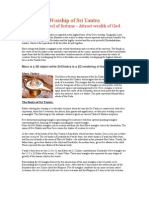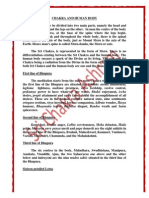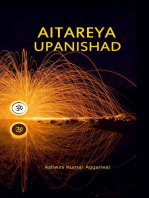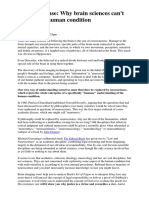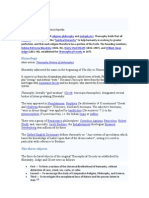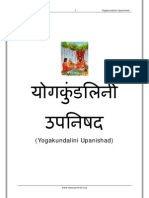Bhavana Upanishad
Bhavana Upanishad
Uploaded by
SoftbrainCopyright:
Available Formats
Bhavana Upanishad
Bhavana Upanishad
Uploaded by
SoftbrainCopyright
Available Formats
Share this document
Did you find this document useful?
Is this content inappropriate?
Copyright:
Available Formats
Bhavana Upanishad
Bhavana Upanishad
Uploaded by
SoftbrainCopyright:
Available Formats
The Bhavana Upanishad
The subject of this upanishad is the yantra of Lalita, also known as the famous Shri Yantra. Yantra, a Sanskrit word, literally means a machine but in Hindu Tantra is usually taken to refer to the devi in linear or geometrical form. Yantras are always used flat. They may be 2dimensional or 3-dimensional (Bhu and Meru arrangements). Every aspect of devi has Her own mantra and yantra. The yantra of Devi Lalita is Shri Yantra. The divinity of the yantra always occupies the centre or apex. The different parts or petals and lines of the yantra are usually arranged in concentric circles (mandalas) and contain rays or sub-limbs of devi. The Shri Yantra has 9 of these mandals, each filled with various aspects of the Devi. In Shri Yantra there are 111 aspects. The Shri Yantra is said to be a geometric form of the human body, which implies that goddess as Macrocosm is one with human being as Microcosm. of the erotic goddess of the tntrika school of Shri Vidy called Lalita<$F`She Who Plays'. All creation, manifestation and dissolution is considered to be a play of devi. Mahtripurasundar is the transcendent beauty of the three cities. This is a description of the goddess as conqueror of the three cities of the demons, or as the triple city (Tripur).> or Mahtripursundar. The yantra is said to represent man and the universe. It consists of nine sub-mandalas, and is shown on the cover of this booklet. Bhavana or meditation consists in the actual practise of placing the different Shaktis upon the body in the manner enjoined in the prayoga (magical application). My brief notes are enclosed by [ and ].
Shri BHAVANOPANISAD
Om. Peace and good fortune be to those who hear this! 1. Shri Guru is Shakti from whom all the elements are created. 2. Of this (Shakti) the body, with its nine orifices, is the form. 3. The Shri Cakra is of ninefold form. 4. Varahi is the father-form. Kurukulla, the mother, is the receiver of offerings. [The yantra is made up of four upward pointing triangles and five downward pointing triangles. Varahi, the devi with a sow's head, is father and contributes 12 kalas (4 x 3). Kurukulla, the menstruating devi, is mother and contributes 15 kalas (5 x 3). Together they give birth to an individual.] 5. The aims of mankind are the (4) oceans. [Dharma, artha, kama and moksha; doing what is right, acquiring wealth, sexuality and liberation.] 6. The body is the island of nine gems. 7. Skin first, then the seven bodily elements and hair (are the nine). [Indian medicine says the human body is created from the dhatus (bodily elements).] 8. Resolutions are the wish-fulfilling trees, Shakti the grove of aeon trees. 9. The tastes sweet, sour, bitter, pungent, astringent and salty are the six seasons. [6 tastes in Tantra, 6 seasons in India] 10. Knowledge is the offering, the known is the oblation, the knower is the sacrificer. The meditation on knowledge-known-knower and on their non-difference is the worship offered to the Shri Cakra. 11. Fate, love, and the other sentiments are Anima and so forth (the other siddhis). [The upanishad begins to describe the 9 circles of the Shri Yantra. The Siddhi Shaktis are on the outermost line] 12. Desire, cruelty, greed, delusion, euphoria, envy, merit and demerit are the eight Shaktis Brahmi being the first. 13. The nine adharas are the Mudra Shaktis. [The nine chakras. Innermost line of the enclosing square of the yantra.] 14. Earth, water, fire, air, aether, ear, skin, eye, tongue, nose, speech, hands, feet, anus, penis, and mind's wavering are the sixteen Shaktis, Kamakarshini being the first. [The 16 petals.] 15. Speech, holding, moving, excreting, generating, rejecting,
accepting and being detached are the eight (Shaktis) like Ananga-Kusuma. [The 8 petals.] 16. Alambusha, Kuhu, Vishvodara, Vatnrta, Hastijihva, Yashovati, Payashvini, Gandhari, Pusha, Shankhini, Sarasvati, Ida, Pingala and Sushumna are the fourteen nadis -- Sarvasankshobhini being the first of the fourteen Shaktis. [The 14 triangles.] 17. Prana, Apana, Vyana, Udana, Samana, lqaga, Kurma, Krikara, Datta and Dhananjaya are the 10 breaths -- Sarvasiddhidana being the first of the devatas of the outer 10 (triangles}. [The 10 triangles. Ten forms of vital breath, bioenergy or prana.] 18. The biological fire is fivefold through differences based on its association with the major breaths -- being Recaka, Pachaka, Shoshaka Dahaka and Plavaka. 19. Ksharaka, Utgaraka, Kshobaka, Jrimbhaka and Mohaka are fires associated with the lesser breaths. They assist digestion in a fivefold way -- what is eaten, chewed, sucked, licked and drunk. 20. These ten kalas of fire are the devatas of the 10 inner (triangles). 21. Cold, warmth, pleasure, unhappiness, desire, sattvas, rajas and tamas are the eight Shaktis Vashini and so forth. [The 8 triangles.] 22. The five flowery arrows are the sense-impressions, of which sound is the first. 23. Mind is the bow made of sugarcane. 24. Attachment is the noose. 25. Repulsion is the goad. [Between the 8 triangles and the central triangles are the 'weapons' of Lalita. See TRIPURA.GIF] 26. Nature, Intelligence and `I am' are the devatas of the inner triangle -- Kameshvari, Bhagamalini, and Vajreshvari. 27. Truly, awareness without attributes is Kameshvara. [Kameshvara means the Lord Kama, the Lord of Sexuality, the spouse of Kameshvari, the Lady Kama, i.e. Shiva and Shakti.] 28. One's very own being, true, blissful, complete, is the supreme Devi Lalita. 29. The red glow of all this is the mirror. 30. Presence of consciousness is siddhi. 31. When one meditates in this way action is homage. 32. The dissolving in one's being of distinctions such as `I', `you', `existence', `non-existence', `what is to be done', `what is not to be done' and the duty to worship is the act of oblation. 33. The thought of the sameness of all objects of mind is the act of nourishment . 34. The fifteen days of the transformation of time are the eternities (the Nityas). [The fifteen days of the lunar fortnight.] 35. One who meditates in this way for three, two or even one moment is liberated whilst living, and is called a Shivayogin. 36. These thoughts on the centre of the cakra have been discussed according to the tenets of the Kadi school. [The Kadi school worships Devi from the outer edge of the yantra to the centre, to the bindu.] 37. Whosoever knows this is a student of the Atharvashiras. [The fourth, non orthodox, Veda.] [The picture is in a separate file called bhavana_gif. --Ceci]
You might also like
- Rajmani Tigunait - The Secret of The Yoga Sutra Samadhi Pada - 2014Document316 pagesRajmani Tigunait - The Secret of The Yoga Sutra Samadhi Pada - 2014Cosmin Gusu82% (11)
- Yantra ManjariDocument310 pagesYantra ManjariMritunjay Pandey100% (8)
- Sri YantraDocument2 pagesSri YantraAkash Chauhan100% (8)
- Tenga Rinpoche - ChoChoDocument200 pagesTenga Rinpoche - ChoChoZealander100% (7)
- Sri Yantra with Golden Ratio Triangle and InscriptionsFrom EverandSri Yantra with Golden Ratio Triangle and InscriptionsRating: 5 out of 5 stars5/5 (2)
- Swami Kripalvananda and YogeshwarDocument28 pagesSwami Kripalvananda and YogeshwarRajbala SinghNo ratings yet
- Sri Yantra Pooja VidhiDocument29 pagesSri Yantra Pooja Vidhiamasssk2210892% (12)
- Miracle of YantrasDocument3 pagesMiracle of YantrasSelvarajoo Vayapury50% (2)
- Math Behind Sri YantraDocument16 pagesMath Behind Sri YantraVidya Warrier100% (1)
- Sri Yantra Simple RitualDocument5 pagesSri Yantra Simple RitualDevender Singh100% (1)
- Dasa Mahavidya YantrasDocument18 pagesDasa Mahavidya YantrasdenramrNo ratings yet
- Ramayana Kakawin Vol. 2 of 3Document292 pagesRamayana Kakawin Vol. 2 of 3Softbrain100% (1)
- Ashta Karma Eight Magical Acts PDFDocument4 pagesAshta Karma Eight Magical Acts PDFErnest GomezNo ratings yet
- The Sri Chakra As A Symbol of The Human Body: P.R. KrishnakumarDocument3 pagesThe Sri Chakra As A Symbol of The Human Body: P.R. Krishnakumarkrish TNo ratings yet
- Dasah Maha VidyaDocument32 pagesDasah Maha VidyaGopi Krishna Yadav Mahavastu100% (1)
- Sri Chakra and Human BodyDocument3 pagesSri Chakra and Human BodyОлег Сафаев83% (6)
- Bhavana Upanishad - EngDocument3 pagesBhavana Upanishad - EngFradxNo ratings yet
- Ari Chakra NbodyDocument3 pagesAri Chakra NbodypropernounNo ratings yet
- Bhavana Upanishad / BhavanopanishadDocument3 pagesBhavana Upanishad / BhavanopanishadAdya TripathiNo ratings yet
- The Dasa Mahavidyas of TANTRADocument19 pagesThe Dasa Mahavidyas of TANTRAsteam100deg1658100% (1)
- Srichakrapooja @Document20 pagesSrichakrapooja @amasssk22108100% (3)
- Sri YantraDocument3 pagesSri Yantramukti banaNo ratings yet
- Manipura ChakraDocument3 pagesManipura ChakranieotyagiNo ratings yet
- Tripur SundariDocument62 pagesTripur Sundaridishita.jadejaNo ratings yet
- Chapter - III: 1. Place of Symbolism and It's RelevanceDocument71 pagesChapter - III: 1. Place of Symbolism and It's Relevanceindrani royNo ratings yet
- Antar YagaDocument15 pagesAntar Yagam.s.subramania sharma100% (1)
- Sri YantraDocument19 pagesSri YantrayoginihillsindiaNo ratings yet
- Shri MahakaliDocument38 pagesShri MahakaliArryanNo ratings yet
- Sri Chakra PujaDocument15 pagesSri Chakra PujaVasantha Kalluraya0% (1)
- Worship of Sri YantraDocument4 pagesWorship of Sri YantraVikram Gopal100% (2)
- Shri Yantra 2 BookDocument245 pagesShri Yantra 2 BookUday DokrasNo ratings yet
- Sri Yantra - The Significance and Symbolism of Its Design: The Cosmos in Abstract FormDocument8 pagesSri Yantra - The Significance and Symbolism of Its Design: The Cosmos in Abstract FormJyotindra100% (3)
- How To Acheive Japa SadhanaDocument4 pagesHow To Acheive Japa SadhanaAnonymous VdXFPOvGx100% (1)
- Bala TripurasundhariDocument15 pagesBala TripurasundharinageshsriramNo ratings yet
- Nava Avarana of Shri CakraDocument15 pagesNava Avarana of Shri CakraconnectingwithcosmicmindNo ratings yet
- Sri Chakra and The BodyDocument3 pagesSri Chakra and The BodyGirish MarlboroNo ratings yet
- Dasa MahavidyasDocument24 pagesDasa Mahavidyasapi-3738901100% (6)
- Dasa Mahavidya Mantras YantrasDocument28 pagesDasa Mahavidya Mantras Yantrasdenramr93% (14)
- Yantra As MeditationDocument10 pagesYantra As MeditationSean Griffin100% (2)
- Sri Chakra-Significance and Pooja DetailsDocument6 pagesSri Chakra-Significance and Pooja Detailssriviseshadri100% (1)
- Sri Chakra PoojaDocument9 pagesSri Chakra PoojaGiredhar VenkataNo ratings yet
- Kamalambikayastava-PunnagaDocument3 pagesKamalambikayastava-PunnagaRamKumarNo ratings yet
- Samhita PDFDocument27 pagesSamhita PDFpsrocker1No ratings yet
- Goddess Lalitha TrishatiDocument3 pagesGoddess Lalitha TrishatiBryanNo ratings yet
- Brought Here by DR Uday Dokras: Sabharathnam SivacharyarDocument9 pagesBrought Here by DR Uday Dokras: Sabharathnam SivacharyarudayNo ratings yet
- Tantra of the Srikula Part I The secret of the Dark Goddess NikumbhilaFrom EverandTantra of the Srikula Part I The secret of the Dark Goddess NikumbhilaNo ratings yet
- Meditations on Sri Jayadeva’s Gita GovindaFrom EverandMeditations on Sri Jayadeva’s Gita GovindaRating: 5 out of 5 stars5/5 (1)
- Chakra Guidebook: Root Chakra: Healing and Balancing One Chakra at a Time for Health, Happiness, and PeaceFrom EverandChakra Guidebook: Root Chakra: Healing and Balancing One Chakra at a Time for Health, Happiness, and PeaceRating: 5 out of 5 stars5/5 (3)
- Chakra Guidebook: Solar Plexus Chakra: Healing and Balancing One Chakra at a Time for Health, Happiness, and PeaceFrom EverandChakra Guidebook: Solar Plexus Chakra: Healing and Balancing One Chakra at a Time for Health, Happiness, and PeaceNo ratings yet
- Chakra: Learning your energies to find balance, health and happinessFrom EverandChakra: Learning your energies to find balance, health and happinessRating: 4 out of 5 stars4/5 (2)
- Sri Yantra Bhavana Upanishad: Essence and Sanskrit GrammarFrom EverandSri Yantra Bhavana Upanishad: Essence and Sanskrit GrammarNo ratings yet
- Chakra Guidebook: Throat Chakra: Healing and Balancing One Chakra at a Time for Health, Happiness, and PeaceFrom EverandChakra Guidebook: Throat Chakra: Healing and Balancing One Chakra at a Time for Health, Happiness, and PeaceNo ratings yet
- Chakra Guidebook: Sacral Chakra: Healing and Balancing One Chakra at a Time for Health, Happiness, and PeaceFrom EverandChakra Guidebook: Sacral Chakra: Healing and Balancing One Chakra at a Time for Health, Happiness, and PeaceNo ratings yet
- Chakra Guidebook: Heart Chakra: Healing and Balancing One Chakra at a Time for Health, Happiness, and PeaceFrom EverandChakra Guidebook: Heart Chakra: Healing and Balancing One Chakra at a Time for Health, Happiness, and PeaceNo ratings yet
- A Brief Summary of the Yajurveda Brahma YagnamFrom EverandA Brief Summary of the Yajurveda Brahma YagnamRating: 5 out of 5 stars5/5 (1)
- Chakra Guidebook: Crown Chakra: Healing and Balancing One Chakra at a Time for Health, Happiness, and PeaceFrom EverandChakra Guidebook: Crown Chakra: Healing and Balancing One Chakra at a Time for Health, Happiness, and PeaceNo ratings yet
- A.J. Penny - BoehmeDocument219 pagesA.J. Penny - BoehmeSoftbrainNo ratings yet
- Rubin & Peplau 1975sDocument13 pagesRubin & Peplau 1975sranconeNo ratings yet
- Baba Premananda BharatiDocument56 pagesBaba Premananda BharatiSoftbrainNo ratings yet
- Pharaonic Occultism The Relationship of Esotericism and Egyptology, 2016Document121 pagesPharaonic Occultism The Relationship of Esotericism and Egyptology, 2016Softbrain50% (2)
- Asprem, 2013, The Problem of Disenchantment PDFDocument642 pagesAsprem, 2013, The Problem of Disenchantment PDFSoftbrainNo ratings yet
- A 12000-Year-Old Shaman Burial From The Southern LevantDocument6 pagesA 12000-Year-Old Shaman Burial From The Southern LevantSoftbrainNo ratings yet
- The Little Clay Cart Mrcchakatika Attributed To King Shudraka PDFDocument217 pagesThe Little Clay Cart Mrcchakatika Attributed To King Shudraka PDFSoftbrainNo ratings yet
- Neurononsense: Why Brain Sciences Can't Explain The Human ConditionDocument4 pagesNeurononsense: Why Brain Sciences Can't Explain The Human ConditionSoftbrainNo ratings yet
- The Aramaic of The Zohar PDFDocument32 pagesThe Aramaic of The Zohar PDFSoftbrainNo ratings yet
- MosheIdel MessianicMystics PDFDocument458 pagesMosheIdel MessianicMystics PDFSoftbrainNo ratings yet
- Muslims On The ManichaeansDocument141 pagesMuslims On The ManichaeansSoftbrainNo ratings yet
- Nicolotti - From The Mandylion of Edessa To The ShroudDocument31 pagesNicolotti - From The Mandylion of Edessa To The ShroudSoftbrainNo ratings yet
- Crawford (1972) The Eternal Spirit - His Person and Powers PDFDocument606 pagesCrawford (1972) The Eternal Spirit - His Person and Powers PDFSoftbrain100% (1)
- Translating Virasaivism The Early Modern Monastery PDFDocument40 pagesTranslating Virasaivism The Early Modern Monastery PDFSoftbrainNo ratings yet
- Paluch, A., (2013) The Enoch-Metatron TraditionDocument264 pagesPaluch, A., (2013) The Enoch-Metatron TraditionSoftbrainNo ratings yet
- Valentin Tomberg Symposium 2009 Report1Document5 pagesValentin Tomberg Symposium 2009 Report1SoftbrainNo ratings yet
- Friedhelm Hardy - Madhavendra Puri: A Link Between Bengal Vaisnavism and South Indian BhaktiDocument19 pagesFriedhelm Hardy - Madhavendra Puri: A Link Between Bengal Vaisnavism and South Indian BhaktiSoftbrainNo ratings yet
- Bala Chitra Ramayana - Children's Picture RamayanaDocument36 pagesBala Chitra Ramayana - Children's Picture RamayanaSoftbrain100% (1)
- Ramayana Kakawin Vol. 3 of 3Document283 pagesRamayana Kakawin Vol. 3 of 3Softbrain100% (1)
- What Is Hatha YogaDocument2 pagesWhat Is Hatha YogaTenzinNo ratings yet
- UG KrishnamurtiDocument1 pageUG KrishnamurtiR ABHISHEKNo ratings yet
- Kama Sutra A Picture Book Pages 1 - 50 - Flip PDF Download - FlipHTML5Document166 pagesKama Sutra A Picture Book Pages 1 - 50 - Flip PDF Download - FlipHTML5Aminna QueensNo ratings yet
- Index of Posts On NPRU Blog With HyperlinksDocument16 pagesIndex of Posts On NPRU Blog With HyperlinksankitNo ratings yet
- Tilopa's Gangāma Māhamudrā InstructionsDocument18 pagesTilopa's Gangāma Māhamudrā InstructionsEugeneNo ratings yet
- Kundalini Final PDFDocument18 pagesKundalini Final PDFRadioguyNo ratings yet
- Esoterism The Initiatic TeachingsDocument15 pagesEsoterism The Initiatic TeachingsTaoshobuddhaNo ratings yet
- 5 Letter Gayatri Mantra For ChildrenDocument3 pages5 Letter Gayatri Mantra For ChildrenkamalbvadharNo ratings yet
- 1Document28 pages1mraghu99100% (2)
- Brahma Vidya UpanishadDocument8 pagesBrahma Vidya UpanishadThirunavukkarasu SivasubramaniamNo ratings yet
- Sri Ramana GitaDocument130 pagesSri Ramana Gitajohn_tuinman_1100% (7)
- TheosophyDocument9 pagesTheosophyGnosticLuciferNo ratings yet
- The Bhagavad Giita - CetanaDocument20 pagesThe Bhagavad Giita - CetanashubhanyNo ratings yet
- 精要明镜- Longchen RabjamDocument3 pages精要明镜- Longchen RabjamLogan Truthe100% (1)
- Bot 08 01 02Document32 pagesBot 08 01 02alexluizyogaNo ratings yet
- A Meditation For Couples - Kirtan Kriya To Clear The Clouds - KundaliniDocument2 pagesA Meditation For Couples - Kirtan Kriya To Clear The Clouds - KundaliniErica YangNo ratings yet
- Vacation With The LordDocument1 pageVacation With The LordWendy Ooi, fsp100% (1)
- Maha Sankarshana PDFDocument3 pagesMaha Sankarshana PDFkrishnaNo ratings yet
- Yoga KundaliniDocument13 pagesYoga Kundalinihjoshi1297No ratings yet
- 16 Bhumaiva Sukham Chand 7Document111 pages16 Bhumaiva Sukham Chand 7Musat AdrianNo ratings yet
- Blessing 4 Oneness - Chakra DhyanaDocument3 pagesBlessing 4 Oneness - Chakra Dhyanasarrks007No ratings yet
- Sanskrit Yogsutra PatanjaliDocument88 pagesSanskrit Yogsutra PatanjaliArchana shuklaNo ratings yet
- Siddhasana PDFDocument2 pagesSiddhasana PDFnithin_v90No ratings yet
- Ishwar Pratyabhijna Vivritti Vimarshini - Abhinava Gupta 5922 Alm 26 SHLF 4 1475 K Devanagari - Kashmir Shaivism Part3Document76 pagesIshwar Pratyabhijna Vivritti Vimarshini - Abhinava Gupta 5922 Alm 26 SHLF 4 1475 K Devanagari - Kashmir Shaivism Part3Kashmir Shaiva and Kashmiri Works at Dharmartha TrustNo ratings yet
- SoundsDocument3 pagesSoundsAbhinav PrateekNo ratings yet
- Sri Ramakrishna Kathamrita Odia Vol-1Document303 pagesSri Ramakrishna Kathamrita Odia Vol-1mukti123No ratings yet





























